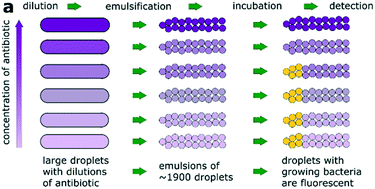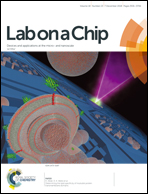Microfluidic screening of antibiotic susceptibility at a single-cell level shows the inoculum effect of cefotaxime on E. coli†
Abstract
Measurement of antibiotic susceptibility at the level of single cells is important as it reveals the concentration of an antibiotic that leads to drug resistance in bacterial strains. To date, no solution for large-scale studies of antibiotic susceptibility at the single-cell level has been shown. Here, we present a method for production and separation of emulsions consisting of subnanoliter droplets that allows us to identify each emulsion by their spatial position in the train of emulsions without chemical barcoding. The emulsions of droplets are separated by a third immiscible phase, thus forming large compartments—tankers—each filled with an emulsion of droplet reactors. Each tanker in a train can be set under different reaction conditions for hundreds or thousands of replications of the same reaction. The tankers allow for long term incubation – needed to check for growth of bacteria under a screen of conditions. We use microfluidic tankers to analyze susceptibility to cefotaxime in ca. 1900 replications for each concentration of the antibiotic in one experiment. We test cefotaxime susceptibility for different initial concentrations of bacteria, showing the inoculum effect down to the level of single cells for more than a hundred single-cell events per tanker. Lastly, we use tankers to observe the formation of aggregates of bacteria in the presence of cefotaxime in the increasing concentration of the antibiotic. The microfluidic tankers allow for facile studies of the inoculum effect and antibiotic susceptibility, and constitute an attractive, label-free screening method for a variety of other experiments in chemistry and biology.



 Please wait while we load your content...
Please wait while we load your content...